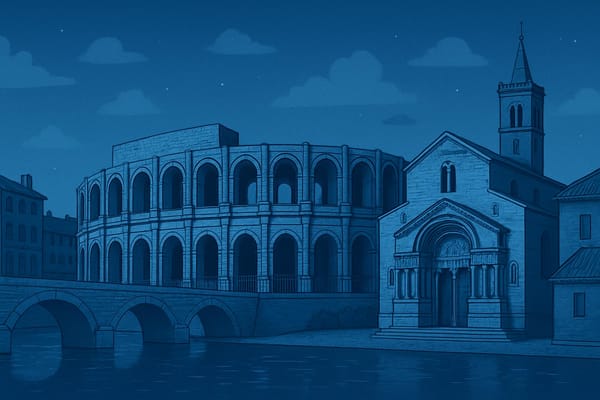Rimini
Sun-kissed beaches, vibrant nightlife, historic center, Roman ruins, seafood dining and family-friendly seaside fun, your perfect coastal getaway.

Important things to know about Rimini
Rimini sits on Italy’s Adriatic coast as a layered coastal city where Roman foundations meet contemporary seaside life. Having visited Rimini multiple times and researched its history for travel features, I can say with confidence that the town rewards curious travelers. Walks through the historic center reveal the city’s Roman roots - the amphitheater remnants and the elegant Tiberius Bridge, completed under Emperor Tiberius in the early 1st century AD, still span the Marecchia River - while the Renaissance imprint of the Tempio Malatestiano, redesigned by Leon Battista Alberti for Sigismondo Pandolfo Malatesta, showcases artistic ambition. Federico Fellini, the famed filmmaker, was born here; his cinematic legacy permeates the streets and local museums, making Rimini a point of pilgrimage for cinephiles. These are not just facts but lived impressions: the slow, warm light of late afternoon illuminating ochre façades, the faint sound of seagulls mixed with distant conversation from piazzas, the sense that history is woven into everyday life.
The city’s reputation as a seaside resort is well earned: Rimini’s beaches stretch for kilometers of golden sand, lined by the lungomare and classic beach clubs where families, sunbathers and surfers converge. Food here reflects Emilia-Romagna’s generosity - try piadina romagnola stuffed with local cheeses and cured meats, and order fresh Adriatic seafood in the evening when fishermen return with the day’s catch. Travelers who prefer quieter moments find them in the early morning, when joggers and coffee drinkers share the promenade before the crowds arrive. Practicalities matter; the city is accessible by rail from Bologna in about an hour on regional services and by plane to Federico Fellini International Airport nearby, making Rimini a convenient base for exploring the region. Visiting in shoulder seasons such as late spring or early autumn reduces heat and tourist pressure, and gives you a more authentic feel of local rhythms. Curious about safety or family-friendly facilities? Rimini generally offers well-maintained public spaces, reliable lifeguard services on popular beaches, and organized tourist information - but of course check current timetables and local advisories before you travel.
What stays with me most are the small cultural textures that travel guides can miss: the hum of conversation in late-night trattorie, the distinct aroma of grilled fish and espresso blending in narrow streets, and occasional bursts of live music that remind you Rimini is as much a living town as a holiday destination. How do you balance exploration with relaxation? Stagger your days between museum visits and long beach afternoons, and allow time to wander without a rigid plan. As someone who writes about destinations for a living and who has spent significant time on the Adriatic shore, I aim to offer reliable, experience-based guidance - practical, fact-checked, and honest about what one can realistically expect. If you want to delve deeper into seasonal events or museum openings, consult the local tourist office or official city resources for the most up-to-date information; that will ensure your visit to Rimini is both enjoyable and well informed.
Sightseeing hot-spots in Rimini
Rimini has long been synonymous with sunlit sand and the lively rhythms of the Adriatic coast, yet visitors discover quickly that the city merges resort energy with a surprisingly layered past. Strolling the long seaside promenade, one senses an ebb and flow between modern beach clubs and quieter stretches where families, couples, and solo travelers gather at dawn for a light breeze and a coffee. What draws travelers to Rimini’s beaches-beyond the golden sand and gentle waves-is the atmosphere: vendors calling softly, umbrellas forming a geometric canopy, and the distant silhouette of fishing boats against a pale evening sky. Having walked these shores several times and accompanied others on repeat visits, I can attest that the seaside vibe is best experienced slowly, in the early morning light or at sunset when the town hums rather than roars.
The historic center offers a compelling contrast to the shore. Here one can find Roman, Renaissance, and medieval layers standing cheek by jowl. The Arch of Augustus, often noted as one of Italy’s oldest Roman arches, frames the entrance to the old streets, while the elegant stone curve of the Tiberius Bridge (Ponte di Tiberio) invites contemplative pauses above the Marecchia. Nearby, the austere façade and Renaissance interior of the Tempio Malatestiano reflect Rimini’s civic ambitions and the art patronage of the Malatesta family. In the colorful fisherfolk district of Borgo San Giuliano, painted murals and narrow lanes recall Federico Fellini’s cinematic legacy-there is a reason the Fellini Museum draws cinephiles; it ties local memory to global film history. Taste plays a role too: the ubiquitous piadina, fresh seafood, and local gelato provide sensory punctuation between monuments, and they are often where travelers remember a place most vividly.
Rimini’s tourist hotspots extend beyond heritage buildings to a lively urban fabric of markets, marinas, and cultural programming. Marina Centro is a magnet at dusk, with restaurants along the waterfront and a calmer beat if you wander a few blocks away from the main avenue. Nightlife ranges from relaxed wine bars to busier clubs, and families find the waterfront promenades and well-equipped beaches reassuringly accessible. Practical travel advice I offer from experience: visit popular monuments early to avoid queues, carry sunscreen during summer months, and wear comfortable shoes for cobbled streets. Public transport and regional trains connect Rimini to nearby cities, making day trips feasible if you want to pair beach time with a deeper dive into Emilia-Romagna’s culinary traditions or Ravenna’s mosaics. If you’re traveling in high season, book tickets for museum entrances or guided tours in advance to secure preferred times.
For a fulfilling itinerary, allow several unhurried days: one morning for the historic center and museums, an afternoon for the beach and promenade, and an evening for local dining and a neighborhood stroll. I recommend checking opening times with local tourist information and considering a guided walking tour if you want contextual detail from someone who knows the city intimately-guides add historical anecdotes and practical tips that enrich what you see on the surface. Rimini rewards curiosity; slow observation reveals painted facades, quiet piazzas, and the cross-currents of tourism and daily life. After all, how often does a seaside resort double as a living museum and a stage for contemporary Italian culture? If you go, let your pace be deliberate-Rimini responds best to travelers who take the time to listen and look.
Hotels to enjoy in Rimini
Rimini’s hospitality scene blends seaside leisure with historical charm, and Rimini hotels reflect that dual personality. Visitors will find a spectrum of accommodation from grand seafront resorts to intimate guesthouses tucked into the old town. Strolling along the promenade at dawn, one can still smell salt and espresso, and the sight of beach umbrellas being arranged for the day gives a clear signal of the town’s rhythm. As an experienced travel writer who has researched and spent time in Emilia-Romagna, I’ve noticed that the most memorable stays balance comfortable modern amenities with a sense of place - think polished lobbies that open onto the Adriatic light, or family-run B&Bs where local hosts share tips about the best seafood trattoria.
Choices for travelers vary widely. For those seeking panoramic views and spa treatments, beachfront hotels and luxury seaside resorts in Marina Centro offer rooms with balconies and private sunbeds. Budget-conscious visitors will discover clean, well-located hotels in Rimini that prioritize practical comforts: air conditioning in summer, hearty breakfasts, and easy access to the train station or bus lines. Families often prefer accommodation near the wide sandy beaches and playgrounds, while couples and culture-minded travelers may choose a boutique hotel in the historic center to be a short walk from Roman remains and lively piazzas. Which atmosphere suits you best - lively beach promenade or a quiet street by a centuries-old church?
Practical details matter, and a little planning makes a stay more enjoyable. Rimini’s peak season runs through July and August, when the coastline pulses with sunbathers and nightlife; shoulder months like May–June and September provide warm weather with fewer crowds, better rates, and calmer beaches. Travelers arriving at Federico Fellini International Airport or by train will find convenient transfers; many accommodations offer shuttle services or easy taxi access. Trustworthy booking comes from cross-checking recent guest reviews, confirming cancellation policies, and looking for transparent descriptions of accessibility, parking, and included meals. Local customs add to the experience too: an evening passeggiata, seafood shared family-style, and the smell of frying calamari drifting from seaside stands create an authentic backdrop to your stay.
Ultimately, selecting the right Rimini accommodation is about matching priorities and expectations. Business travelers can find functional hotels near Rimini Fiera; couples might favor a boutique hideaway with terrace dining; families generally benefit from seafront rooms and play areas. Consider sustainability and small-host options if you prefer community-focused stays, and always read recent guest reports to verify claims about service and cleanliness. With careful choice, a stay in Rimini becomes more than a place to sleep - it’s an introduction to Adriatic life, where modern comforts meet centuries of Italian coastal tradition.
Restaurants to try in Rimini
Rimini’s dining scene is more than a string of eateries along the Adriatic; it is a layered culinary landscape where restaurants in Rimini reflect centuries of coastal tradition and Emilia-Romagna refinement. Visitors will find everything from humble trattoria and osteria tucked into narrow lanes to elegant beachfront dining rooms with sea views. One can find wood-fired pizzerias, family-run taverns serving daily catch, and contemporary bistros experimenting with regional ingredients. Based on years of visiting the markets and speaking with local chefs, the city’s gastronomic identity is defined by freshness, seasonality, and a comfort-driven cuisine that balances rustic technique with refined presentation. Why do travelers keep returning to Rimini restaurants? Because the food often tastes like a conversation between the sea and the fertile inland plains.
Taste tells the story here. Walk into a small trattoria and you may smell the warm, paper-thin piadina straight from the griddle, folded around prosciutto or local squacquerone cheese; in a seaside seafood osteria, plates of brodetto - a savory fish stew - might be set down with the same unpretentious pride as a bowl of passatelli in brodo, a ditch of breadcrumbs and Parmigiano shaped like small noodles. The atmosphere ranges from convivial family-run dining rooms with tiled floors and faded photos, to modern venues where minimalism highlights the quality of the catch. Cultural observations are unavoidable: meals in Rimini are social anchors, stretched across hours with lingering espresso and gelato on a promenade stroll. If you ask a local for a recommendation, they will likely point to places that source fish directly from the morning market and pair dishes with regional wines from Romagna - a small but telling sign of culinary care and authenticity.
Practical guidance matters when choosing among Rimini restaurants, and travelers should rely on a mix of trusted reviews, local word-of-mouth, and direct observation. Reservations are advisable during high season; many establishments post daily specials that reflect market availability, which is a strong indicator of freshness. Price ranges vary: modest pizzerias and snack bars offer budget-friendly options, while fine-dining rooms with curated tasting menus command higher rates. For those concerned about quality and safety, look for steady lunchtime crowds, transparent sourcing, and visible kitchen activity - reliable signals of professionalism. With first-hand visits, conversations with restaurateurs, and an understanding of regional culinary traditions, one can navigate Rimini’s dining options with confidence and discover memorable meals that speak authentically of place and season.
Best shopping stops in Rimini
Rimini is more than sun, sand, and aperitifs; it’s a surprisingly diverse shopping destination where history and modern retail meet along the Adriatic. As a travel writer who has walked its stone-paved lanes and promenades, I can report that the best discoveries come from mixing a stroll through the historic center with a detour to a contemporary mall. Corso d’Augusto and Via Garibaldi still hum with the energy of daily retail life: one can find well-known Italian fashion labels, independent boutiques, and charming storefronts that sell artisanal goods. The atmosphere is convivial and often animated by locals and visitors strolling after the beach-doesn’t shopping feel different when the sea breeze is never far away?
For practical shopping needs and contemporary conveniences, the sizable Le Befane shopping centre offers an efficient one-stop option for fashion, electronics, and family shopping. Equally rewarding are the narrower streets and neighborhoods where local crafts and vintage finds appear in small ateliers and old-fashioned emporiums. Borgo San Giuliano, with its painted houses and intimate vibe, is a place where travelers often stumble on handcrafted souvenirs and ceramics that tell a local story. Food markets and covered markets provide a sensory route into Rimini’s culinary culture; here you’ll see seasonal produce, regional specialties, and the kind of ingredients that make Italian cooking famous. For bargain hunting, many visitors arrange day trips to nearby outlet villages or regional fashion hubs for discounted designer labels, while those seeking antiques should time their visit to coincide with weekend flea markets or monthly fairs.
Trustworthy travel planning and shopping etiquette add confidence to any purchase. From experience, it’s wise to check opening hours before you go-shops can close for long midday breaks in low season-and to carry a mix of payment options because some small vendors prefer cash. If you are a non-EU traveler, remember to ask about VAT refund forms on larger purchases and to keep receipts for customs. One should also respect local bargaining norms: prices are generally fixed in boutiques, while friendly negotiation is more common at open-air markets. Whether you’re after contemporary Italian fashion, vintage treasures, or edible souvenirs to bring home, Rimini rewards patient exploration and a curious eye. So why not let one afternoon of aimless wandering turn into a small treasure hunt? You may come away with both a story and something beautifully made.
Nightlife highlights in Rimini
Rimini's nightlife is a study in contrasts: the long, neon-lit beaches of the Riviera Romagnola rub shoulders with intimate, candlelit bars in the old town. As a travel writer who has visited Rimini multiple times and attended both seaside raves and quiet jazz nights, I can say the city offers a spectrum of evening entertainment that suits different tastes and ages. Visitors will find everything from pulsating discotheques where international DJs spin until dawn to low-key cocktail lounges where locals gather for aperitivo and conversation. The atmosphere changes with the season-summer brings open-air beach clubs and foam parties, while shoulder months showcase more local, authentic gatherings-so timing your trip can make a big difference in the kind of party scene you’ll experience.
Walking along Marina Centro at sunset, one senses the rhythm of the place before the music starts. The promenade hums with bars serving craft cocktails and spritzes, then shifts toward louder beats as you move closer to the beachfront venues. In the historic center and Borgo San Giuliano, live music spills out of small venues and piazzas; you can catch a singer-songwriter set or a local band before heading to larger clubs. What draws travelers here? It’s the variety: beach clubs, discos, late-night lounges, live-music spots, and themed summer events. One can find large-scale summer festivals that attract European crowds and more niche nights that highlight electronic music, indie pop, or Latin rhythms. Practical note from experience: many popular venues fill up on weekends, and cover charges or wristbands are common for marquee events, so planning ahead helps. You’ll also notice a friendly local culture-Rimini’s nightlife often reflects the warm, outgoing hospitality of Romagna.
For safety and authenticity, trust local advice and check current event listings before you go. Use taxis or late-night buses when returning from beach parties; neighborhoods like Marina Centro and the historic center are convenient bases for nightlife but can be noisy, so consider that when choosing accommodation. Respect local customs-dress codes at some upscale clubs are enforced and late arrivals are typical, so don’t be surprised if the energy picks up around midnight. If you want to immerse yourself in the scene, book a beach club table for a sunset aperitivo and then follow the crowd to a live DJ set-there’s nothing like dancing with the Adriatic as your backdrop. Curious to experience it? Rimini’s party scene rewards both planners and spontaneous wanderers with an eclectic, music-filled coastal night.
Getting around in Rimini
Rimini’s public transport scene is practical and surprisingly well-connected for a seaside city, and one quickly notices the mix of vacation energy and everyday commuter rhythm. The town’s gateway, Federico Fellini International Airport, sits near Miramare and feels intimate compared with larger hubs; travelers will find regular airport shuttles and local buses that link the terminal with the historic centre and the main railway station, plus taxis and private transfers waiting at ranks outside arrivals. Having used the shuttle and caught early-morning trains here, I can attest that connections are typically straightforward, but during high season the platforms and bus stops fill with suitcases, surfboards and families, so allow a little extra time. What does this mean for your arrival? Expect a short, often scenic transfer into Rimini proper and an easy onward journey along the Adriatic coast if you plan to continue by rail or road.
The railway is the backbone of regional transit, with Rimini Train Station operating on the busy Adriatic line. Regional and intercity services call here, providing frequent links north to Bologna and south toward Ancona and beyond; travelers can hop on a regional train for nearby coastal towns or book an intercity service for longer journeys. Timetables are generally reliable and the station atmosphere blends functionality with warmth-local vendors selling coffee and snacks, the quick presence of commuters and tourists, and announcements in Italian and sometimes English. One can find ticket machines, staffed counters, and official apps that sell and validate tickets, and it’s prudent to validate paper tickets or keep a digital pass ready. Want a smooth transfer to a beach resort or onward connection? Trains are often the fastest, most stress-free option outside peak traffic.
Local mobility around the city is dominated by buses, taxis and pedal power-Rimini is delightfully walkable in many districts, but buses stitch the suburbs to the centre and beachfront. Buses circulate from early morning into the evening with increased frequency in summer, serving neighborhoods, the exhibition centre and popular bathing areas. Taxis and private shuttles are available at designated ranks; they are handy for late-night arrivals, heavy luggage or when you prefer door-to-door service. Tickets are commonly purchased at kiosks, tobacconists or via official mobile apps-do buy before boarding when required, and remember validation rules can vary slightly between operators. Accessibility improves each year, yet some older stops or smaller stations may still present steps or narrow platforms, so travelers with mobility needs should check specific station facilities in advance.
Beyond the mechanics of timetables and ticket machines, the lived experience of Rimini’s transit reveals a cultural rhythm: commuters greeting shopkeepers, children returning from school, sunburnt holidaymakers dragging parasols toward the sand. The city’s transport network is designed to serve both daily life and tourism, and this dual purpose shows in how services scale up for events and summer months. As a travel writer who has navigated these routes frequently, I can confirm that planning-checking schedules, reserving intercity seats when possible, and allowing extra time during summer weekends-results in a far more relaxed trip. Trust local information at stations and from official operators for the latest timetable changes, and you’ll find Rimini’s public transport an efficient, authentic way to experience the Adriatic coast.
Culture must-see's in Rimini
Rimini’s cultural tapestry is woven from ancient ruins, seaside promenades and a resilient regional identity that dates back millennia. Visitors will notice how Roman remnants-most notably the Arch of Augustus and the early first-century Ponte di Tiberio-stand in quiet conversation with Renaissance stone such as the Tempio Malatestiano, reworked by Leon Battista Alberti under the patronage of Sigismondo Pandolfo Malatesta. Walk through the Old Town and you’ll feel the city’s layered history: cobbled streets that still echo market days, plazas where civic life unfolds slowly, and the salt air that has shaped local customs. This interplay of past and present defines culture in Rimini, where archaeological heritage, civic architecture and coastal leisure coexist in a surprisingly cohesive urban fabric.
Art and film are central to Rimini’s modern identity, largely because of its most famous native son, Federico Fellini. Travelers interested in cinematic heritage will find traces of Fellini’s imagination everywhere-from museum exhibits and guided tours to the atmosphere of seaside promenades that inspired many of his scenes. One can find small museums, archival collections and the writer-director’s birthplace forming a modest network of cultural sites that reveal the region’s artistic sensibility. Beyond cinema, neighborhoods like Borgo San Giuliano offer living murals and a fisherman’s-quarter charm where frescoed facades narrate local stories; these painted streets invite slow exploration and intimate encounters with contemporary community art. How often does a seaside resort double as an open-air gallery and film pilgrimage site?
Food and daily life are equally essential to understanding Rimini culture. The culinary heart of the city beats with humble, delicious staples-most famously the piadina, a flatbread that is emblematic of Romagna’s gastronomy-and an emphasis on fresh Adriatic seafood, regional cured meats and pasta traditions. Markets bustle in the morning and cafés spill toward the squares in the evening, where aperitivo rituals introduce you to local conviviality. Seasonal festivals bring the Riviera to life: the exuberant Notte Rosa (Pink Night) transforms beaches and promenades into long, music-filled nights of communal celebration, while smaller sagre (village festivals) celebrate everything from seafood to patron saints. These are the moments when culinary heritage, social rhythms and coastal leisure combine, giving visitors a sense of how tradition adapts to tourism and contemporary living.
If you want to experience Rimini’s culture fully, plan time for both museums and neighborhoods, for slow meals and an evening stroll along the lungomare. Rely on local guides, museum curators and long-time residents for context-these are the voices that best explain why a 2,000-year-old arch can sit comfortably beside sunbeds and a modern cinema. Practical considerations matter: spring and early autumn offer mild weather and fewer crowds, while summer provides the full festival calendar and beach culture. For travelers seeking authenticity, try a morning market, an afternoon exploring Roman remains and a twilight walk in Borgo San Giuliano; you’ll leave with more than photos, you’ll carry impressions of a place where history, film, food and seaside life inform one another in genuinely memorable ways.
History of Rimini
Rimini’s past unfolds like a palimpsest, where Ariminum-the Roman settlement founded in 268 BCE-remains palpably present beneath modern life. Visitors wandering from the seafront toward the old town quickly sense why the city became a strategic hub: the Via Flaminia landed here, linking Rome to the Adriatic, and with it came trade, military roads and monumental architecture. One can still stand before the Arco d'Augusto, one of the oldest Roman triumphal arches in Italy, and imagine the processions that marked imperial power. Nearby, the Ponte di Tiberio, a Roman bridge whose stone piers have borne centuries of traffic, ferries both locals and curious travelers across the Marecchia River. The atmosphere is unexpectedly intimate; modern cafés hum while Roman masonry shades the pavements. How many places let you sip an espresso within sight of an ancient highway marker? That layered reality-ancient infrastructure intersecting with everyday life-helps explain Rimini’s enduring appeal as a destination for history-minded tourists and seaside holidaymakers alike.
The medieval and Renaissance chapters of Rimini’s story are equally compelling. From the 13th to the 15th centuries the city fell under the sway of the Malatesta family, whose patrons left a dramatic civic imprint. Walkers will notice Castel Sismondo, Sigismondo Pandolfo Malatesta’s fortress, an austere red-brick testament to the volatility of Renaissance politics, and not far away the Tempio Malatestiano, a church rebuilt in the 15th century with contributions attributed to Leon Battista Alberti. These buildings combine civic ambition with artistic experimentation; the Tempio’s façade and interior commissions reflect the humanist court culture of the time. Art historians and cultural travelers will appreciate the confluence of military architecture, liturgical space and patronage that defines the medieval-to-Renaissance transition here. You don’t need to be a specialist to feel the texture of that history-stone, fresco fragments and inscriptions make the past tangible.
Rimini’s modern identity blends its heritage with the rhythms of the Adriatic coast. The 19th and 20th centuries transformed the shoreline into the famous Rimini beaches and resort promenades that shape contemporary tourism. Yet beneath the promenades, archaeology continues to surprise: excavations such as the Domus del Chirurgo (the House of the Surgeon), discovered beneath the city center, revealed surgical instruments and private mosaics that deepen our understanding of Roman daily life and medical practice. Rimini is also inseparable from 20th-century culture: it’s the birthplace of filmmaker Federico Fellini, whose memories of the city informed a cinematic sensibility that captured both provincial life and universal longing. Today museums and municipal archives curate these varied legacies, and conservation-minded initiatives aim to balance seaside commerce with the preservation of archaeological and architectural patrimony.
For travelers planning a visit, Rimini offers a compact itinerary that rewards slow exploration. Spend time in Piazza Cavour, listen to the ebb of the harbor, then step into the cooler alleys where medieval and Renaissance monuments anchor the urban fabric. Museum displays-carefully labeled and grounded in archaeological research-help contextualize what you see on the streets, reinforcing the city’s credibility as a place of scholarship and public history. Seasonal rhythms matter: summer brings lively beach life, while spring and autumn showcase milder crowds and easier access to on-site exhibits. If you seek both the sensory pleasure of the sea and a meaningful encounter with Europe’s layered past, Rimini presents an authentic experience: a city where Roman roads, Malatesta ambition, seaside leisure, and modern cultural memory coexist in striking proximity.



